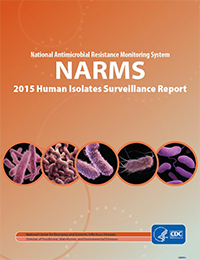New Report on Antibiotic-resistant Infections

The NARMS 2015 Human Isolates Surveillance Report provides the most recent nationwide data on antibiotic resistance among six types of bacteria that can cause diarrhea or bloodstream infections. These bacteria are commonly spread through food. For this report, NARMS conducted whole genome sequencing (WGS) of all nontyphoidal Salmonella collected in 2015. Genetic data provided by this sequencing can be used to identify resistance genes and predict antimicrobial resistance.
Key findings:
- WGS data provides more information on the types of genes that make bacteria resistant to clinically important drugs. For example, among 65 ceftriaxone-resistant Salmonellaisolates from sick people tested in 2015, 8 had a type of resistance gene that is rare in the United States and is often linked to international travel.
- Among nontyphoidal Salmonella, 5.8 percent of the isolates tested were not susceptible to ciprofloxacin, meaning the antibiotic may not kill the bacteria and it may multiply. This was the highest percentage since testing began in 1996. Among Enteritidis (the most common Salmonella serotype), 14% were not susceptible, up from 8% in 2014. Ciprofloxacin, an important treatment option for severe Salmonella infections in adults.
- Decreased susceptibility to azithromycin (DSA) among Shigella increased to 9.8% in 2015. DSA among Shigella sonnei was 6.1% in 2015 and among species flexneri, DSA increased to 33%, up from 22% in 2014. Azithromycin is one of the preferred antimicrobial agents for adults and children with Shigella infections.
For more information:
|
Report: Surveillance for Foodborne
Disease Outbreaks
A new MMWR report, “Surveillance for Foodborne Disease Outbreaks — United States, 2009–2015,” draws from 5,760 outbreaks reported to CDC’s Foodborne Disease Outbreak Surveillance System from 2009 through 2015. These outbreaks accounted for 100,939 illnesses, 5,699 hospitalizations, and 145 deaths.
Out of all outbreaks, 5,583 were single-state, but the 177 multi-state outbreaks were responsible for 11% of illnesses, 34% of hospitalizations, and 54% of deaths. Although only a small subset of illnesses are associated with recognized outbreaks, data from outbreak investigations provide insight into the foods and pathogens that cause illnesses and the settings and conditions in which they occur.
- Norovirus and Salmonella were the most commonly reported causes of outbreaks.
- Fish, dairy, and chicken were the most commonly implicated foods in outbreaks.
- Chicken, pork, and seeded vegetables were responsible for the most outbreak-related illnesses.
Online Foodborne Outbreak
Training for Health Professionals
The module takes approximately 90 minutes to two hours. Learners may complete it in one session, or pause and return to the module to finish in multiple sessions. It has three chapters—one set in an outpatient clinic, one at a local public health department, and one at a multidisciplinary meeting after the outbreak has resolved. The scenario is based on a multistate foodborne outbreak that occurred in 2015-16, but the details of the patients, clinicians, and the local health department are fictional. The training was developed through CDC funding.
| 







No hay comentarios:
Publicar un comentario